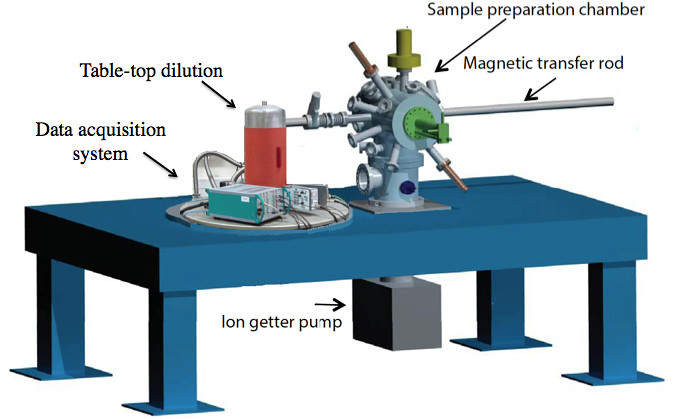Low-T STM
A major challenge in molecular electronics is the controlled deposition of a single molecule onto the device or into the nanogap of a junction. For example, for electromigrated junctions, the most widely used technique consists in first depositing a large number of molecules onto the junction, then opening a nanogap hoping that a single molecule falls into this nanogap. Although this method is somewhat successful some uncertainty remains about the inserted molecule. In addition, heating during electromigration might alter the molecule. Thus new techniques must be developed that would be selective, precise in space and reproducible in time.
 |
|
Fig.: Rough scheme of the table-top dilution with UHV sample preparation chamber, all mounted on an optical table. The UHV sample preparation chamber is equipped with an AFM/STM and molecule deposition systems. A magnetic transfer rod allows the sample transfer between the preparation chamber and the table-top cryostat. A load lock allows the introduction of samples into the preparation chamber. Later, additional molecule deposition systems will be mounted directly on the cryostat. |
We intend to reduce the uncertainty usually associated with molecular integrated nanoscale junctions and reach a control well beyond the current state-of-the-art. To perform controlled integration of a single molecule in the devices, we need to control and monitor the deposition of a single molecule. This requires the development of experimental techniques to integrate the molecule in-situ, directly on the operating device at low temperature. For this goal, we will first build an ultra-high-vacuum (UHV) deposition system, similar to those used in the scanning-tunnelling-microscope (STM) community. Fig. 1 illustrates the custom-built system capable of performing a variety of characterization and manipulation procedures. A UHV sample preparation and transfer system sits on an optical table directly next to our home-built UHV table-top 3He-4He dilution refrigerator. Samples can be moved throughout the UHV system on a transfer plate using a magnetic transfer rod. The sample preparation chamber has two molecule deposition sources, a molecule spray evaporator, and an argon ion sputter gun. The preparation chamber also has a room temperature atomic-force-microscope combined with a scanning-tunnelling-microscope (AFM/STM) that operates in UHV. This enables us to examine samples during or after preparation and before we transfer them into the table-top refrigerator.

